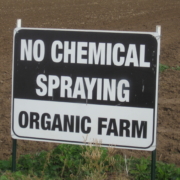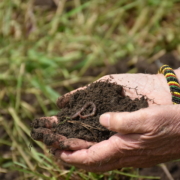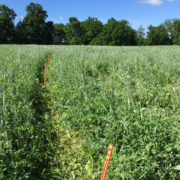Residue Testing for Chemicals in Agricultural Soil
By Lee Rinehart, NCAT Agriculture Specialist
Each year, a half million tons of pesticides are applied to U.S. farmland to produce crops (U.S. Geological Survey). Because of persistent pesticide use, much of our soils, as well as some of the crops and food products produced, are contaminated with chemical residues (NSW Department of Primary Industries). Additionally, land can become contaminated by heavy metals from agricultural chemicals and fertilizers, biosolids, wastewater, metal mining, and and milling, or by airborne sources (stack or duct emissions) (Wuana and Okieimen). Other sources of pollution include landfills and waste disposal sites, highways and parking lots, and construction sites. Residues and metals from industrial sites can remain in the soil at high levels well after the industrial activity has ceased. And it can be difficult to obtain actual numbers of all contaminated sites in the United States because a monitoring system of all polluted sites in in this country does not exist (Food and Agriculture Organization of the United Nations).
Soil testing on suspect sites is the best method for determining if soil is safe for food production or human and other animal habitation. Soil residue tests can determine if residues are present to help farmers and gardeners assess their risk, manage exposure, and remediate contaminated sites. The importance of soil testing on suspect sites cannot be over-stated, since approximately 59% of the American population lives within three miles of a contaminated site (Food and Agriculture Organization of the United Nations).
Below are some useful resources for getting soil tested for specific pesticides or heavy metals. However, the first place to check is your local land-grant university. Your state Cooperative Extension will have information on whether university chemical and heavy metal testing labs exist in your state.
Labs Providing Contaminated Soil Testing Services
Cooperative Extension Testing Labs. Find your state and contact your local Extension office for more information on labs in your area.
Heavy Metals Analysis, Ward Laboratories
Heavy Metals Testing, Cornell Soil Health Laboratory
Soil Health Testing
Though not directly related to chemical testing, soil health testing can help farmers and gardeners obtain baseline data from which to set goals for soil improvement. Soil health practices such as the addition of organic matter (i.e., clean compost) to soils, maintaining a pH of 6.5 or higher, and mulching or planting cover crops can help mitigate exposure from contaminated soils. The labs listed below provide soil-health testing that goes beyond nutrient and pH analysis by assessing the soil’s biological functions, which are indicators of soil health and the soil’s ability to immobilize chemical compounds.
Useful Resources for Understanding Soil Contamination
Soil Contaminants, Soil Science Society of America
Soil Testing for Environmental Contaminants – Interpreting Your Heavy Metals Test Results, University of New Hampshire
Urban Agriculture Soil Contaminants and Soil Testing, University of California
Bioassay for Pesticide Residue – A Home Test
Chemical residues can negatively affect plant growth and may lead to chemical exposure to humans and other animals that encounter the soil or food produced on contaminated soil. A bioassay is a quick and easy way to determine if chemical residues (insecticides and herbicides) are in a soil, and to test if the soil can be safely planted to a crop. This is accomplished by planting a susceptible plant in the soil to be tested to observe how the plant germinates and grows in the suspect soil. Depending on the chemical present, the test plants will manifest specific symptoms such as leaf curling, stunted growth, or discoloration (North Carolina State Extension). For more information on conducting a bioassay, see the resources below.
Conducting a Bioassay For Herbicide Residues, North Carolina State Extension
Check your soil for herbicide residue, Grainews
What Can I Do to Prevent Exposure to Potential Contaminants in My Soil?
First, get the soil tested. Find out about the history of the field, lawn, or site. Was it previously farmed conventionally using chemicals? Did the prior owner or user use chemicals or store potentially contaminated substances on the land? Was the site used for manufacturing? Then, depending on the test results and the severity of contamination, there are some practices you can do to help prevent exposure (Cornell Cooperative Extension):
- Use clean soil and compost
- Use raised beds
- Avoid treated wood (railroad ties and pressure-treated wood)
- Maintain healthy soil and neutral pH
- Use cover crops and/or mulch to reduce soil splash and dust
- Monitor children, pets, and livestock
- Clean farm and garden tools and implements after use
- Wash your hands after garden work
- Wash and/or peel vegetables harvested from the garden
Related ATTRA Resources:
Toolkit: How to Reduce Synthetic Fertilizer Use
Other Resources:
Manage Compost and Soil Contaminated with Broadleaf Herbicides in Residential, School, and Community Gardens, North Carolina State University Extension
Herbicide Contaminated Soil and Amendments, Montana State University Extension
This blog is produced by the National Center for Appropriate Technology through the ATTRA Sustainable Agriculture program, under a cooperative agreement with USDA Rural Development. ATTRA.NCAT.ORG.


 USDA NRCS
USDA NRCS
 USDA photo by Scott Bauer
USDA photo by Scott Bauer